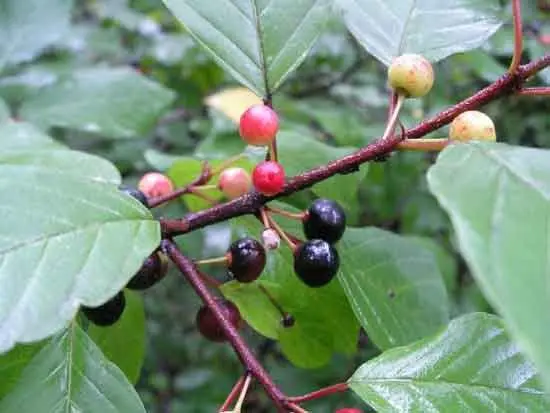Contents
- Useful properties and use of buckthorn, buckthorn bark
- Botanical characteristics of buckthorn
- Useful properties of buckthorn
- The use of buckthorn
- Buckthorn as a laxative
- Buckthorn for weight loss
- buckthorn root
- Buckthorn fruits
- Buckthorn leaf
- Buckthorn berries
- Buckthorn during pregnancy
- Buckthorn alder
- The buckthorn is fragile
- Buckthorn American
- Contraindications to the use of buckthorn
Useful properties and use of buckthorn, buckthorn bark
Botanical characteristics of buckthorn

Buckthorn – This is a fairly large shrub, the height of which can vary from 1,5 to 7 m. The trunk of the plant is covered with gray bark. Petiolate leaves have a wide elliptical shape. Flowers with pedicels do not exceed 1 cm in length and are arranged in bunches of several pieces. Many insects are attracted by special nectaries that are very well developed in buckthorn. Buckthorn fruit is a spherical drupe about 1 cm in size, which has 2-3 seeds. The presented plant blooms in late May – early June, and it reproduces by seed. This shrub prefers fertile soil and often grows on forest edges, in forests, in ravines and along river banks. You can meet this plant in the European part of Russia, as well as in Western Siberia.
Useful properties of buckthorn
Anthraglycosides were found in large quantities in the leaves, bark, fruits and buds of the brittle buckthorn, which determine the main main pharmacological effect of this unusual plant: it has an irritating property. In addition, the fruits and leaves of this shrub contain ascorbic acid and alkaloids. Buckthorn brittle is a mild laxative.
The use of buckthorn
Buckthorn bark. Buckthorn bark has been collected for medicinal purposes since ancient times. It is effective for chronic constipation. To prepare a decoction, you need 1 tablespoon of chopped bark and 200 ml of water. It is recommended to take half a glass of funds every day before bedtime.
Buckthorn as a laxative
Buckthorn bark is used in medicine to create drugs that help get rid of constipation. Along with this, such a plant helps to restore stool in a short time.
Buckthorn for weight loss
Due to the fact that this plant has a clear laxative effect, it is often used for weight loss in combination with popular protein diets. In addition, buckthorn can be used for a complete bowel cleansing.
Buckthorn extract – This is a pharmaceutical agent that must be taken in 40 drops for chronic constipation.
buckthorn root
Buckthorn root is used in choleretic preparations. The composition of such a drug includes 20 g of flax seeds, 10 g of cumin fruits, 15 g of brittle buckthorn roots, 15 g of angelica roots, 20 g of nettle leaves, 10 g of peppermint and 30 g of sage leaves. This collection is poured into 200 g of boiling water and insisted for 1 hour. It must be taken warm daily. In addition, buckthorn roots can be useful for making decorative plywood, shoe nails and various carved crafts.
Buckthorn fruits
A decoction of brittle buckthorn fruits perfectly cures various skin diseases.
Buckthorn leaf
With careful research, alkaloids were found in buckthorn leaves, which contribute to the normalization of blood circulation. A decoction of fresh leaves has long been used to restore strength and improve appearance.
Buckthorn berries
Buckthorn berries are an excellent anthelmintic agent. However, they should be taken with extreme caution, since only a dozen unripe berries can even lead a person to death.
Buckthorn during pregnancy
This plant is contraindicated for ladies in an interesting position due to the fact that it causes a significant rush of blood into the small pelvis, which in turn can lead to miscarriage.
Buckthorn alder
Buckthorn alder is a fairly tall tree with dark brown bark and a smooth trunk. Petiolate leaves are oval in shape. Small flowers are collected in bunches. The presented plant blooms from May to July. It can be found along the shores of lakes in the Caucasus, in the eastern part of Russia, in Central Asia and Siberia. For medicinal purposes, the medicinal bark of buckthorn is mainly used, which must be collected in early spring. The bark tastes bitter and has no smell. For the treatment of chronic hemorrhoids, this plant is the best choice.
Buckthorn tincture: to prepare a tincture of buckthorn bark, pour the crushed raw materials of the plant with 30 percent alcohol. The ratio will be 1: 5. Before starting treatment for hemorrhoids, the tincture should be kept for at least 10 days at room temperature.
The buckthorn is fragile
Buckthorn brittle (asplenifolia) is a large tall shrub that has narrow foliage. The leaves of the plant are fern-like. This type of buckthorn blooms in July and early July with small yellowish flowers that attract insects with their aroma. The dark red fruits of this beautiful plant are spherical and highly poisonous.
Buckthorn American
Buckthorn American grows in the form of a shrub that reaches a height of 8 meters. Numerous inconspicuous flowers are presented in axillary clusters. Ripe fruits are black. This plant can be found on the Pacific coast of North America. After a year of storage, American buckthorn is used as a laxative, making liquid extracts and decoctions.
Contraindications to the use of buckthorn
Taking medicines that are made from the fresh bark can cause nausea and in some cases vomiting, as well as stomach pain. Such negative properties of grass, as a rule, are neutralized during long-term storage. It should also be noted that during the use of decoctions, elementary precautions must be taken so that diarrhea does not occur.









